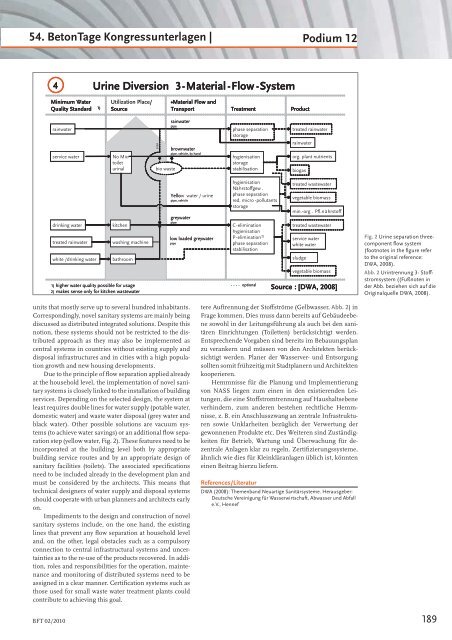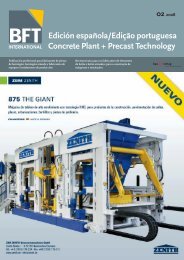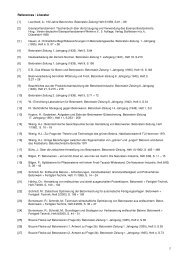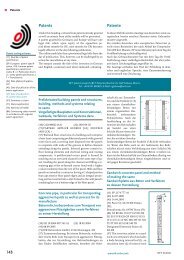Concrete Plant + Precast Technology Betonwerk ... - BFT International
Concrete Plant + Precast Technology Betonwerk ... - BFT International
Concrete Plant + Precast Technology Betonwerk ... - BFT International
Sie wollen auch ein ePaper? Erhöhen Sie die Reichweite Ihrer Titel.
YUMPU macht aus Druck-PDFs automatisch weboptimierte ePaper, die Google liebt.
54. BetonTage Kongressunterlagen |<br />
4<br />
units that mostly serve up to several hundred inhabitants.<br />
Correspondingly, novel sanitary systems are mainly being<br />
discussed as distributed integrated solutions. Despite this<br />
notion, these systems should not be restricted to the distributed<br />
approach as they may also be implemented as<br />
central systems in countries without existing supply and<br />
disposal infrastructures and in cities with a high population<br />
growth and new housing developments.<br />
Due to the principle of fl ow separation applied already<br />
at the household level, the implementation of novel sanitary<br />
systems is closely linked to the installation of building<br />
services. Depending on the selected design, the system at<br />
least requires double lines for water supply (potable water,<br />
domestic water) and waste water disposal (grey water and<br />
black water). Other possible solutions are vacuum systems<br />
(to achieve water savings) or an additional fl ow separation<br />
step (yellow water, Fig. 2). These features need to be<br />
incorporated at the building level both by appropriate<br />
building service routes and by an appropriate design of<br />
sanitary facilities (toilets). The associated specifi cations<br />
need to be included already in the development plan and<br />
must be considered by the architects. This means that<br />
technical designers of water supply and disposal systems<br />
should cooperate with urban planners and architects early<br />
on.<br />
Impediments to the design and construction of novel<br />
sanitary systems include, on the one hand, the existing<br />
lines that prevent any fl ow separation at household level<br />
and, on the other, legal obstacles such as a compulsory<br />
connection to central infrastructural systems and uncertainties<br />
as to the re-use of the products recovered. In addition,<br />
roles and responsibilities for the operation, maintenance<br />
and monitoring of distributed systems need to be<br />
assigned in a clear manner. Certifi cation systems such as<br />
those used for small waste water treatment plants could<br />
contribute to achieving this goal.<br />
<strong>BFT</strong> 02/2010<br />
Urine Diversion 3-Material -Flow -System<br />
Minimum Water<br />
Quality Standard 1)<br />
Minimum Water Utilization Place/<br />
Quality Standard Source<br />
1) Source<br />
service water<br />
No Mixtoilet<br />
urinal<br />
1) higher water quality possible for usage<br />
2) makes sense only for kitchen wastewater<br />
bio waste<br />
•Material Flow and<br />
Transport Treatment Product<br />
rainwater<br />
rainwater phase separation<br />
storage<br />
drinking water<br />
treated rainwater<br />
white /drinking water<br />
kitchen<br />
washing machine<br />
bathroom<br />
pipe<br />
pipe<br />
brownwater<br />
pipe, vehicle, by hand<br />
Yello Yellow water / urine<br />
pipe, vehicle<br />
greywater<br />
pipe<br />
low loaded greywater<br />
pipe<br />
hygienisation<br />
storage<br />
stabilisation<br />
hygienisation<br />
Nährstoffgew .<br />
phase separation<br />
red. micro -pollutants<br />
storage<br />
C-elimination<br />
hygienisation<br />
P-elimination 2)<br />
P-elimination 2)<br />
phase separation<br />
stabilisation<br />
- - - - optional<br />
rainwater<br />
Podium 12<br />
treated rainwater<br />
org. plant nutrients<br />
biogas<br />
treated wastewater<br />
vegetable biomass<br />
min.-org . Pfl.nährstoff<br />
treated wastewater<br />
service water<br />
white water<br />
sludge<br />
vegetable biomass<br />
Source : [DWA, 2008]<br />
tere Auftrennung der Stoff ströme (Gelbwasser, Abb. 2) in<br />
Frage kommen. Dies muss dann bereits auf Gebäudeebene<br />
sowohl in der Leitungsführung als auch bei den sanitären<br />
Einrichtungen (Toiletten) berücksichtigt werden.<br />
Entsprechende Vorgaben sind bereits im Bebauungsplan<br />
zu verankern und müssen von den Architekten berücksichtigt<br />
werden. Planer der Wasserver- und Entsorgung<br />
sollten somit frühzeitig mit Stadtplanern und Architekten<br />
kooperieren.<br />
Hemmnisse für die Planung und Implementierung<br />
von NASS liegen zum einen in den existierenden Leitungen,<br />
die eine Stoff stromtrennung auf Haushaltsebene<br />
verhindern, zum anderen bestehen rechtliche Hemmnisse,<br />
z. B. ein Anschlusszwang an zentrale Infrastrukturen<br />
sowie Unklarheiten bezüglich der Verwertung der<br />
gewonnenen Produkte etc. Des Weiteren sind Zuständigkeiten<br />
für Betrieb, Wartung und Überwachung für dezentrale<br />
Anlagen klar zu regeln. Zertifi zierungssysteme,<br />
ähnlich wie dies für Kleinkläranlagen üblich ist, könnten<br />
einen Beitrag hierzu liefern.<br />
References/Literatur<br />
DWA (2008): Themenband Neuartige Sanitärsysteme. Herausgeber:<br />
Deutsche Vereinigung für Wasserwirtschaft, Abwasser und Abfall<br />
e.V., Hennef<br />
Fig. 2 Urine separation threecomponent<br />
fl ow system<br />
(footnotes in the fi gure refer<br />
to the original reference:<br />
DWA, 2008).<br />
Abb. 2 Urintrennung 3- Stoff -<br />
stromsystem ((Fußnoten in<br />
der Abb. beziehen sich auf die<br />
Originalquelle DWA, 2008).<br />
189












